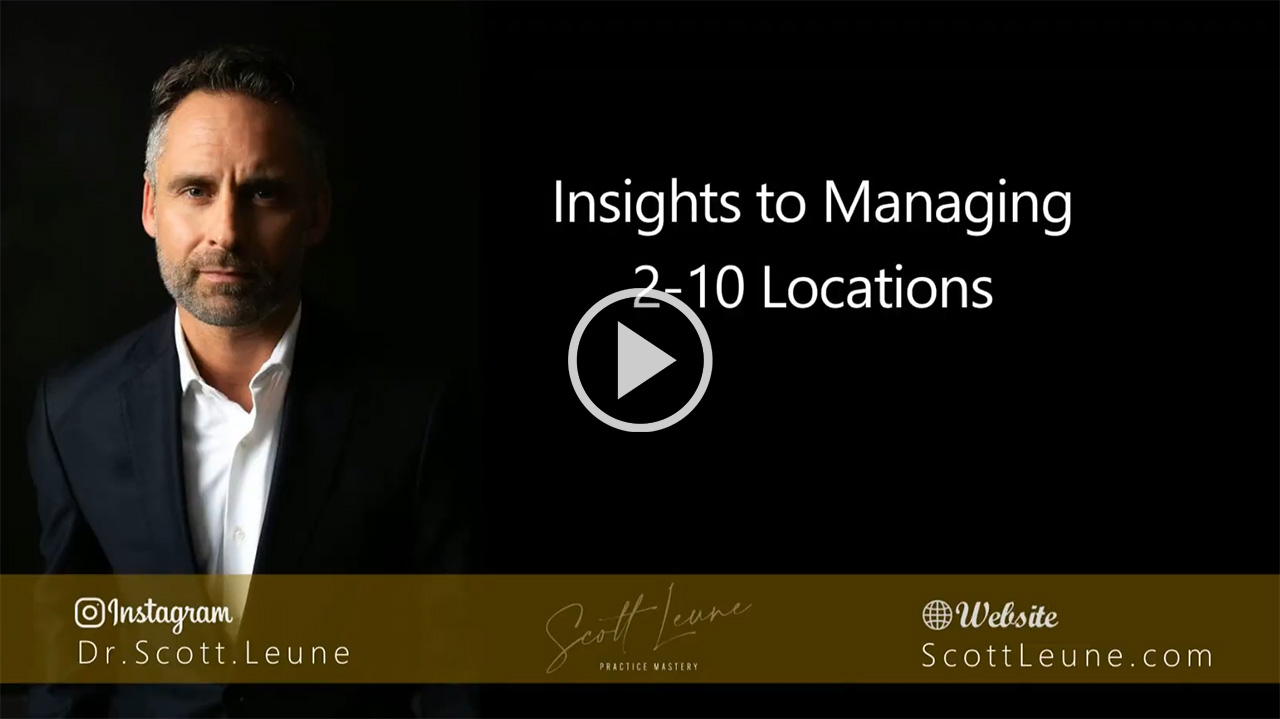Managing 2 to 10 Locations in Your Dental Practice – webinar by Dr. Scott Leune
Dr. Scott Leune provides deep insights into the challenges and strategies for managing multiple dental practice locations, specifically targeting owners looking to scale from 2 to 10 locations. Drawing from his extensive experience of helping dentists scale to over 200+ locations, he shares battle-tested strategies to ensure consistency, profitability, and sustainable growth.
Scott emphasizes the importance of consistency—from patient care to operations and financial performance—as the key to managing multiple locations effectively. He breaks down financial strategies, leadership structures, and operational efficiencies necessary for dentists to transition from a single location to a multi-location practice owner.
Check out the upcoming webinars: https://scottleune.com/webinars/
Key Highlights of the webinar:
1. Consistency is Everything
According to Scott Leune, consistency is the foundation of scaling successfully. Without it, expansion becomes a “duct-tape operation” where some locations thrive while others struggle. To avoid this, owners need to establish:
- Standardized patient care protocols;
- Uniform operational processes (phone answering, financial presentations, etc.);
- Consistent culture across all locations;
Why? If each location operates differently, inefficiencies will compound over time, making it difficult to maintain quality, predictability, and financial health.
2. Understanding EBITDA and Valuation
Scott stresses that financial success isn’t just about revenue—it’s about EBITDA (Earnings Before Interest, Taxes, Depreciation, and Amortization). The valuation of a practice is based on EBITDA multiplied by an industry-specific multiple.
For example:
- $1M in EBITDA × 6.5-9x multiple = $6.5M to $9M valuation
- This multiple increases with growth predictability and scalability
Scott introduces the “multiple arbitrage” concept: Buying a single practice at a 4x multiple, integrating it into a larger organization valued at 8x, and instantly increasing its worth.
3. The One-to-Four Location Growth Challenge
Scott highlights that the hardest transition is from one location to four. Many owners fall into this trap:
- First location thrives—Owner is fully engaged.
- Second location struggles—Owner splits time, productivity drops.
- Third location loses money—Owner is stretched thin, barely breaking even.
- Frustration sets in—More work, less profit.
Scott’s solution?
- Make location one extremely profitable before adding a second.
- Transition the owner away from general dentistry by focusing on high-value specialty procedures (implants, ortho, wisdom teeth).
- Hire an associate strategically without cutting too deeply into the owner’s production.
4. Strategic Associate Hiring & Avoiding Profitability Drops
Scott warns against a common hiring mistake: Replacing an owner-dentist with an associate too soon. He explains that associates:
- Diagnose less
- Have lower case acceptance
- Are less efficient in production
If the owner hands over too many days, production drops, overhead increases, and the practice loses two-thirds of its ability to pay expenses.
Solution:
- Gradually transition the owner into a part-time high-production specialist while adding an associate only when patient volume justifies it.
- Keep associates accountable for production minimums.
5. Leadership & Management Structure for Scaling
Scott explains that successful multi-location practices have a clear leadership hierarchy:
- Office Manager (OM) at each location
- Not just an admin but an accountability manager ensuring consistency.
- Regional Manager (RM)
- Oversees 3-4 locations, manages OMs, and ensures operational and financial consistency.
- Owner’s Role (at 4+ locations)
- Stops doing hygiene exams and focuses on high-value cases + management.
- Becomes a strategic leader, working on growth, recruiting, and financial structuring.
At 10+ locations, the owner fully transitions to CEO mode, leading culture, strategy, and expansion rather than day-to-day operations.
6. Financial Optimization & Cost Control
Scott highlights four major areas where multi-location practices can reduce costs without sacrificing quality:
- Staffing Costs: Implement virtual assistants for insurance verification, scheduling, and admin tasks.
- Hygiene Wages: Use an assisted hygiene model with a hybrid compensation structure.
- Lab & Supplies: Leverage bulk purchasing, vendor negotiations, and AI-powered cost tracking.
- Management Efficiency: Use regional managers to streamline operations across multiple locations.
7. Recruiting & Retaining Associate Dentists
Scott acknowledges the challenge of competing with DSOs for talent but emphasizes private practice strengths:
- More autonomy;
- More mentorship;
- Higher earning potential;
- Phantom stock or profit-sharing options for long-term retention;
To stand out, owners must market their culture and align compensation with performance and ownership opportunities.
Final Takeaways:
- Master consistency before scaling.
- EBITDA determines financial success, not just collections.
- Carefully transition from single-location owner to multi-location Dental CEO.
- Be strategic about associate hiring to avoid revenue dips.
- Implement a professional management team to maintain profitability & efficiency.
- Use financial strategies to cut costs and boost EBITDA.
- Recruit & retain talent by differentiating from DSOs.
Scott’s Closing Advice:
“Decide what you want your next chapter to look like. Without compromise, start that next chapter. Don’t get stuck.”
If you found this insightful, Scott recommends attending his 16-hour intensive training seminars for in-depth strategies on scaling, managing, and leading multiple locations profitably.

